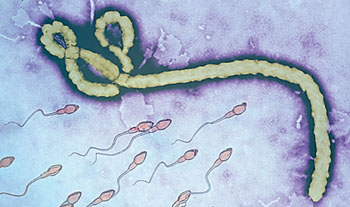Ebolavirus Found in Semen Months After Symptom Onset
By LabMedica International staff writers
Posted on 05 Nov 2015
The main mode of transmission is direct contact with the blood or body fluids of a person with Ebolavirus disease (EVD) or from the body of a person who died from EVD; however, Ebolavirus can persist in the body fluids of survivors during convalescence, which may result in transmission of the virus.Posted on 05 Nov 2015
Previously, survivors of EVD were told to practice sexual abstinence or to use a condom for three months after recovery. These recommendations were based on virus-isolation results from semen specimens obtained from eight survivors of EVD or Marburgvirus disease in previous epidemics in which the longest period that infectious virus was found in semen after the onset of symptoms was 82 days.

Image: Colorized transmission electron micrograph (TEM) revealed some of the ultrastructural morphology displayed by an Ebolavirus virion with supplemented spermatozoa (Photo courtesy of Frederick A. Murphy/CDC, and Graphic by Mark Murrman).
A large international team of scientist led by those from the Sierra Leone Ministry of Health (Freetown, Sierra Leone) recruited a convenience sample of 100 male survivors from the Western Area District of Sierra Leone, which includes the capital of Freetown. They identified study participants who, at informational events that were held in conjunction with survivor associations, indicated interest in participation, as well as persons who were referred from Ebola treatment centers. A member of the study team administered a questionnaire to all the participants at the time of enrollment to gather information about their EVD episode, self-reported health status, sexual behavior, and sociodemographic characteristics, and the date of EVD onset was self-reported.
Semen specimens were collected and refrigerated at 5 °C to 8 °C for no longer than three days and transported to the field laboratory. The team performed quantitative reverse transcription polymerase chain reaction (RT-PCR) testing using Ebolavirus–specific gene targets (NP and VP40) and the human β2-microglobulin (B2M) gene. A specimen was considered positive if the VP40 and NP gene targets were both detected within 40 cycles of replication. The specimen was considered to be negative if neither Ebolavirus gene targets were detected nor the findings with respect to B2M status were positive. The findings were ruled to be indeterminate if either the VP40 or the NP gene target was detected but not both. Amplification of B2M served as an extraction control and RNA quality control.
A total of 46 of the 93 men (49%) had a specimen that was positive on quantitative RT-PCR. Ebolavirus RNA was detected in the semen of all 9 men from whom a specimen was obtained during the first three months after the onset of illness, in the semen of 26 of 40 men (65%) from whom a specimen was obtained at four to six months, and in the semen of 11 of 43 men (26%) from whom a specimen was obtained at seven to nine months. The longest time after the onset of a participant’s EVD symptoms that a semen specimen obtained at baseline remained positive on quantitative RT-PCR was 284 days. Indeterminate results were encountered in 10 initial specimens in the range of 152 to 273 days after the onset of symptoms.
Bruce Aylward, MD, an Assistant Director-General at the World Health Organization (Geneva, Switzerland) said, “These results come at a critically important time reminding us that while Ebola case numbers continue to plummet, Ebola survivors and their families continue to struggle with the effects of the disease. This study provides further evidence that survivors need continued, substantial support for the next 6 to12 months to meet these challenges and to ensure their partners are not exposed to potential virus.” The study was published on October 14, 2015, in the New England Journal of Medicine (NEJM).
Related Links:
Sierra Leone Ministry of Health
World Health Organization









 assay.jpg)




